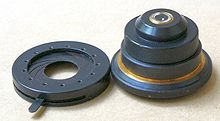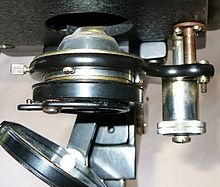- Condenser (microscope)
-
A condenser is one of the main components of the optical system of many transmitted light compound microscopes. A condenser is a lens that serves to concentrate light from the illumination source that is in turn focused through the object and magnified by the objective lens. It is a basic component of almost all compound light microscopes manufactured since the 19th Century. An equivalent condenser, which focuses an electron beam, is a basic component of both transmission and scanning electron microscopes.
Contents
Description
Condensers are located above the light source and under the sample in an upright microscope, and above the stage and below the light source in an inverted microscope. They act to gather light from the microscope's light source and concentrate it into a cone of light that illuminates the specimen. The intensity and angle of the light cone must be adjusted (via the size of the diaphragm) for each different objective lens with different numerical apertures. Condensers typically consist of a variable-aperture diaphragm and one or more lenses. Light from the illumination source of the microscope passes through the diaphragm and is focussed by the lens(es) onto the specimen. After passing through the specimen the light diverges into an inverted cone to fill the front lens of the objective. There are four types of condenser:
- Abbe – The simplest of condensers is the Abbe condenser. It contains two lenses that produce an image of the light source that is surrounded by a blue and red colour at its edges.
- Aplanatic – Aplanatic condensers are corrected for spherical aberration
- Achromatic – Achromatic condensers are corrected for chromatic aberrations
- Aplanatic and achromatic condensers are corrected for both spherical and chromatic aberrations.
Abbe condenser
The Abbe condenser is named for its inventor, Ernst Karl Abbe, who developed it in 1870. The Abbe condenser, which was originally designed for Zeiss, is mounted below the stage of the microscope. The condenser concentrates and controls the light that passes through the specimen prior to entering the objective. It has two controls, one which moves the Abbe condenser closer to or further from the stage, and another, the iris diaphragm, which controls the diameter of the beam of light. The controls can be used to optimize brightness, evenness of illumination, and contrast. Abbe condensers are particularly important for magnifications of above 400X.
This condenser is composed of two lenses a plano-convex lens somewhat larger than a hemisphere and a large bi-convex lens serving as a collecting lens to the first. The focus of the first lens is traditionally about 2mm away from the plane face coinciding with the sample plane. A pinhole cap can be used to align the optical axis of the condenser with that of the microscope. The Abbe condenser is the basis for most modern light microscope condenser designs.[1][2]
Aplanatic and achromatic condensers
Several types of condensers represent improvements on the optical design of a basic Abbe condenser. An aplanatic condenser corrects for spherical aberration in the concentrated light path, while an achromatic condenser corrects for chromatic aberration. Even more highly improved is an achromatic-aplanatic condenser, which corrects for both.
Specialized condensers
Dark field and phase contrast setups are based on an Abbe, aplanatic, or achromatic condenser, but to the light path add a dark field stop or various size phase rings. These additional elements are housed in various ways. In most modern microscope (ca. 1990s–), such elements are housed in sliders that fit into a slot between the illuminator and the condenser lens. Many older microscopes house these elements in a turret-type condenser, these elements are housed in a turret below the condenser lens and rotated into place.
Specialised condensers are also used as part of Differential Interference Contrast and Hoffman Modulation Contrast systems, which aim to improve contrast and visibility of transparent specimens.
In epifluorescence microscopy, the objective lens acts not only as a magnifier for the light emitted by the fluorescing object, but also as a condenser for the incident light.
Condensers and numerical aperture
Like objective lenses, condensers vary in their numerical aperture (NA). It is NA that determines optical resolution, in combination with the NA of the objective. Different condensers vary in their maximum and minimum numerical aperture, and the numerical aperture of a single condenser varies depending on the diameter setting of the condenser aperture. In order for the maximum numerical aperture (and therefore resolution) of an objective lens to be realized, the numerical aperture of the condenser must be matched to the numerical aperture of the used objective. The technique most commonly used in microscopy to optimize the light pathway between the condenser (and other illumination components of the microscope) and the objective lens is known as Köhler illumination.
The maximum NA is limited by the refractive index of the medium between the lens and the sample. As with objective lenses, a condenser lens with a maximum numerical aperture of greater than 0.95 is designed to be used under oil immersion (or, more rarely, under water immersion), with a layer of immersion oil placed in contact with both the slide/coverslip and the lens of the condenser. An oil immersion condenser may typically have NA of up to 1.25. Without this oil layer, not only is maximum numerical aperture not realized, but the condenser is not able to precisely focus light on the object. Condensers with a numerical aperture of 0.95 or less are designed to be used without oil or other fluid on the top lens and are termed dry condensers. Dual dry/immersion condensers are basically oil immersion condensers that can nonetheless focus light with some degree of precision even without oil between the top lens and the slide. However, a dedicated dry condenser with an NA of 0.95 or less will focus light more precisely than a dry/immersion condenser used without oil immersion.
References
- "Abbe condenser", Photonics Dictionary (abridged online edition), Pittsfield MA: Laurin Publishing, 2006.
- "Abbe, Ernst", Encyclopædia Britannica.
- "Glossary of microscope terms", Microbus (website), 2003.
- "Anatomy of the Microscope: Substage Condenser" by Mortimer Abramowitz and Michael W. Davidson, Olympus Microscopy Resource Center, 2006.
External links
- "Anatomy of the Microscope: Substage Condenser" by Mortimer Abramowitz and Michael W. Davidson, Molecular Expressions. (Slightly different than the version found at Olympus site.)
- "The Condenser" by Paul James, Micscape Magazine (online publication), February 2002.
Categories:- Lenses
- Microscope components
Wikimedia Foundation. 2010.



